People on the internet love to argue. Especially board gamers, it seems. Among those things are definitions of what is a eurogame or thematic game or card game or abstract strategy game.
Well, there is just a lot of gray area. Nonetheless, Dylan and I are here to brave the comments section telling me which of these games don’t qualify to bring you our Top 10 Abstract Strategy Games. In general, my definition of abstract is that there is low-to-no luck, highly tactical in nature, and often best (but not always) at 2 players.
One thing I don’t believe abstracts have to have is a lack of theme. Pasted on or not, theme doesn’t break an abstract. It’s about the gameplay and the mechanisms. While you won’t see Monolith Arena/Neuroshima Hex on this list because I believe it probably has too much randomness in the draw to meet my definition, it isn’t because of the presence of a theme.
10. Katarenga
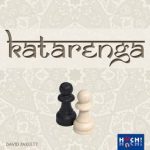 Andrew: The premise in Katarenga is simple. Each player starts with 8 pawn-shaped chess pieces on their side of the board. To win, get 2 of your pieces across the game board. However, each piece can move in different chess-like patterns determined by the color of the space they currently occupy. If you are on a yellow square you move like a bishop. If you stop on a green square, your next move must follow the rules of a knight’s movement. It can be incredibly difficult to think turns ahead as the possibilities for movement start to increase exponentially.
Andrew: The premise in Katarenga is simple. Each player starts with 8 pawn-shaped chess pieces on their side of the board. To win, get 2 of your pieces across the game board. However, each piece can move in different chess-like patterns determined by the color of the space they currently occupy. If you are on a yellow square you move like a bishop. If you stop on a green square, your next move must follow the rules of a knight’s movement. It can be incredibly difficult to think turns ahead as the possibilities for movement start to increase exponentially.
2 Players • Ages 8+ • 20 minutes • $60
10. The Climbers (review)
 Dylan: When you first see The Climbers all set up, you are more inclined to think it’s a dexterity game. But The Climbers is very much a low-luck spatial abstract game. It’s about recognizing which pieces are available to use to climb higher and higher on the wooden structure. Add in some spendable extras like two sizes of ladders and a blocking disk. It can have some odd moments due to the way the structure is formed at the beginning and the options of blocks available for a player on their turn.
Dylan: When you first see The Climbers all set up, you are more inclined to think it’s a dexterity game. But The Climbers is very much a low-luck spatial abstract game. It’s about recognizing which pieces are available to use to climb higher and higher on the wooden structure. Add in some spendable extras like two sizes of ladders and a blocking disk. It can have some odd moments due to the way the structure is formed at the beginning and the options of blocks available for a player on their turn.
2-4 Players • Ages 18+ • 45 minutes • $35
9. YINSH
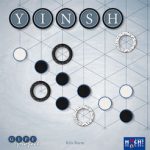 Andrew: The GIPF series of abstract games has produced seven abstract games from designer Kris Burm. The best of those is YINSH. Players will start with five rings placed on the board. Each turn you move a ring, leaving behind a marker of your color. When your ring moves it can jump over any number of pieces (but must land on the first empty space after jumping a piece) and all of those are flipped to the opposite color. Your goal is to get five of your color in a row. When you do, you score a point, but one of your rings is removed from the game. Once you score three points, you win!
Andrew: The GIPF series of abstract games has produced seven abstract games from designer Kris Burm. The best of those is YINSH. Players will start with five rings placed on the board. Each turn you move a ring, leaving behind a marker of your color. When your ring moves it can jump over any number of pieces (but must land on the first empty space after jumping a piece) and all of those are flipped to the opposite color. Your goal is to get five of your color in a row. When you do, you score a point, but one of your rings is removed from the game. Once you score three points, you win!
2 Players • Ages 9+ • 30-60 minutes • $35
9. Azul (review)
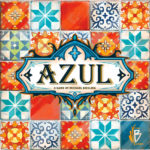 Dylan: While more of a drafting game as opposed to an abstract strategy game, Azul offers tough decisions for what benefits you and hurts others just as much. The tension that is created through waiting for the perfect haul and eying the other player boards for opportunities to hand them broken tiles. While the coasters are filled in a random manner, that is the only aspect of luck and hidden information Azul contains. It’s a widely beloved game with two spinoffs/sequels and a few minor expansions. I enjoy Azul and do consider it an abstract, but it would rank higher on a list of drafting games.
Dylan: While more of a drafting game as opposed to an abstract strategy game, Azul offers tough decisions for what benefits you and hurts others just as much. The tension that is created through waiting for the perfect haul and eying the other player boards for opportunities to hand them broken tiles. While the coasters are filled in a random manner, that is the only aspect of luck and hidden information Azul contains. It’s a widely beloved game with two spinoffs/sequels and a few minor expansions. I enjoy Azul and do consider it an abstract, but it would rank higher on a list of drafting games.
2-4 Players • Ages 8+ • 30-45 minutes • $29
8. Santorini
 Andrew: Santorini is one of the best looking abstract games out there. Rather than just pieces on a board, Santorini floats into 3D space as you have to move and build on various levels. If you ever have one of your two workers standing on the third level of a tower, you win the game. There are optional variable player powers, each named after the gods of Greek mythology to add more interest after repeated plays. Because of its great table presence and easy to explain rules, Santorini is one of the most approachable abstract games today.
Andrew: Santorini is one of the best looking abstract games out there. Rather than just pieces on a board, Santorini floats into 3D space as you have to move and build on various levels. If you ever have one of your two workers standing on the third level of a tower, you win the game. There are optional variable player powers, each named after the gods of Greek mythology to add more interest after repeated plays. Because of its great table presence and easy to explain rules, Santorini is one of the most approachable abstract games today.
2-4 Players • Ages 8+ • 20 minutes • $20
8. Mexica
 Dylan: The most abstract game in the Mask Trilogy from Kramer and Kiesling, Mexica is quite a sandbox when it comes to movement options and scoring opportunities. In essence, it’s an area control game, but it’s also important to have your player pawn nearby to construct temples or bridges. Most of the game revolves around the use of canals and Lake Texoco for faster movement. The backbone of Mexica is creating districts and claiming control of them using temples, and the larger territories scoring more. The only random aspect of the game comes from the set-up, where a certain number of district tokens are used and chosen randomly.
Dylan: The most abstract game in the Mask Trilogy from Kramer and Kiesling, Mexica is quite a sandbox when it comes to movement options and scoring opportunities. In essence, it’s an area control game, but it’s also important to have your player pawn nearby to construct temples or bridges. Most of the game revolves around the use of canals and Lake Texoco for faster movement. The backbone of Mexica is creating districts and claiming control of them using temples, and the larger territories scoring more. The only random aspect of the game comes from the set-up, where a certain number of district tokens are used and chosen randomly.
2-4 Players • Ages 10+ • 90 minutes • $32
7. Nova Luna
 Andrew: Nova Luna is a recently released game that was nominated for the Spiel des Jahres. You’ll draft tiles from the center and each tile has multiple conditions that, if met, will score points. So while each tile you draft can help you fulfill your previously made goals, it gives you more to shoot for as well. And the drafting of tiles uses a Patchwork-esque system where the tile you choose has a value that will move your player marker around the track. The player farthest back on the track gets to keep picking, allowing you to potentially grab a few lower value tiles in a row.
Andrew: Nova Luna is a recently released game that was nominated for the Spiel des Jahres. You’ll draft tiles from the center and each tile has multiple conditions that, if met, will score points. So while each tile you draft can help you fulfill your previously made goals, it gives you more to shoot for as well. And the drafting of tiles uses a Patchwork-esque system where the tile you choose has a value that will move your player marker around the track. The player farthest back on the track gets to keep picking, allowing you to potentially grab a few lower value tiles in a row.
1-4 Players • Ages 8+ • 30-60 minutes • $46
7. Volo
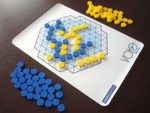 Dylan: When I attempt to describe Volo, I say it’s like if Go introduced movement. The goal is to connect all of our pieces in one large group. Pieces (which are thematically flocks of birds), can either be added or moved. If added, they cannot be adjacent to friendly pieces. If moved, an entire group must move together in a straight line and grow as a result. Volo is a unique mix of offense and defense, similar to many classic abstracts. It may not appear to be that dangerous if two small flocks combine to become one, but there’s always a desire to place a piece that would block any other flocks from joining up. But adding another piece then makes the win condition further out of your own grasp. It’s an interesting question that Volo poses on every turn.
Dylan: When I attempt to describe Volo, I say it’s like if Go introduced movement. The goal is to connect all of our pieces in one large group. Pieces (which are thematically flocks of birds), can either be added or moved. If added, they cannot be adjacent to friendly pieces. If moved, an entire group must move together in a straight line and grow as a result. Volo is a unique mix of offense and defense, similar to many classic abstracts. It may not appear to be that dangerous if two small flocks combine to become one, but there’s always a desire to place a piece that would block any other flocks from joining up. But adding another piece then makes the win condition further out of your own grasp. It’s an interesting question that Volo poses on every turn.
2 Players • Ages 10+ • 45 minutes • $25
6. Billabong
 Andrew: I was introduced to the wonderful 1992 classic Billabong at BGG.CON recently. This game has players controlling a group of kangaroos trying to make their way around the billabong in the center of the board. Each turn you can move any kangaroo one space in any direction, or you can hop over any other kangaroo. To do so, you’ll count the number of spaces between you and that kangaroo and you must land the same number of spaces away from them. So if you are three spaces from them, you’ll move seven total spaces, landing three spaces away on the other side. Then you can keep jumping in that same manner as long as there is a legal move you’d like to take. It’s dead simple but a whole lot of fun.
Andrew: I was introduced to the wonderful 1992 classic Billabong at BGG.CON recently. This game has players controlling a group of kangaroos trying to make their way around the billabong in the center of the board. Each turn you can move any kangaroo one space in any direction, or you can hop over any other kangaroo. To do so, you’ll count the number of spaces between you and that kangaroo and you must land the same number of spaces away from them. So if you are three spaces from them, you’ll move seven total spaces, landing three spaces away on the other side. Then you can keep jumping in that same manner as long as there is a legal move you’d like to take. It’s dead simple but a whole lot of fun.
2-4 Players • Ages 10+ • 30 minutes • €20
6. Alien City
 Dylan: This may be the oddest entry, in that it’s never had a proper release. Alien City is played using components from two game systems, the Loony Pyramids and the Piecepack. Two different structures, towers and domes, are played on an 8×10 grid. At the end of the game, claimed towers are scored based on the number of pieces within two spaces that are not the same color multiplied by the spaces it takes to get to a tower of the same color. Continuing with the oddities, the negative space of the grid creates a network that may never be interrupted and is used when determining distances. There are very few games similar to Alien City, and even more so in the abstract strategy genre. The only bit of randomness featured is the variable setup of the grid. Alien City is bizarre, in mechanics, scoring, and even acquiring.
Dylan: This may be the oddest entry, in that it’s never had a proper release. Alien City is played using components from two game systems, the Loony Pyramids and the Piecepack. Two different structures, towers and domes, are played on an 8×10 grid. At the end of the game, claimed towers are scored based on the number of pieces within two spaces that are not the same color multiplied by the spaces it takes to get to a tower of the same color. Continuing with the oddities, the negative space of the grid creates a network that may never be interrupted and is used when determining distances. There are very few games similar to Alien City, and even more so in the abstract strategy genre. The only bit of randomness featured is the variable setup of the grid. Alien City is bizarre, in mechanics, scoring, and even acquiring.
2 Players • Ages 8+ • 40 minutes
5. The Climbers (review)
 Andrew: The premise of The Climbers is simple, try to get your pawn to the highest point possible. Each turn you’ll be able to move and rotate a block, and then move your climber. The key is the pawn can only move onto block faces that match its color (or the neutral white color). As the game progresses it gets increasingly cutthroat as you try to limit your opponent’s options. The game doesn’t end until a round passes with only one player being able to move up. Then the player at the top wins.
Andrew: The premise of The Climbers is simple, try to get your pawn to the highest point possible. Each turn you’ll be able to move and rotate a block, and then move your climber. The key is the pawn can only move onto block faces that match its color (or the neutral white color). As the game progresses it gets increasingly cutthroat as you try to limit your opponent’s options. The game doesn’t end until a round passes with only one player being able to move up. Then the player at the top wins.
2-4 Players • Ages 8+ • 45 minutes • $35
5. Shobu (review)
 Dylan: I’ll join in with the rest of the Board Game Quest in singing the praises of 2019’s Shobu. Shobu has the look and feel of a game designed in centuries prior. It uses a movement system that is unused in any other abstract game. At least in my experience. The playtime is quick, yet offers a large pool of decisions. And even when a player looks to be close to defeat, the board layout always determines if that player is actually on the brink of losing. We’ve spoken of it at length on the site and expect to hear more about it, maybe even again on this list…
Dylan: I’ll join in with the rest of the Board Game Quest in singing the praises of 2019’s Shobu. Shobu has the look and feel of a game designed in centuries prior. It uses a movement system that is unused in any other abstract game. At least in my experience. The playtime is quick, yet offers a large pool of decisions. And even when a player looks to be close to defeat, the board layout always determines if that player is actually on the brink of losing. We’ve spoken of it at length on the site and expect to hear more about it, maybe even again on this list…
2 Players • Ages 8+ • 15-30 minutes • $30
4. Ni-Ju
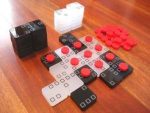 Andrew: Nestor Games are self-published abstracts out of Spain that generally come packaged in pencil cases. (Volo, on Dylan’s list above, is also published by Nestor.) This collection of abstracts is vast and offers a huge amount of variety, but Ni-Ju stands out as one of the best. In Ni-Ju, each tile shows a pattern and if you can fill that pattern around that tile, you win. So each piece acts both as a new potential victory condition as well as a means to fulfill other victory conditions and/or blocking one of your opponent’s options to win. Both players have the exact same tiles accessible to them and each one is a unique pattern that only exists once. Ni-Ju can certainly be brain-melting but leads to some great plays where you don’t have to play purely offensively or defensively but can do both in a single action.
Andrew: Nestor Games are self-published abstracts out of Spain that generally come packaged in pencil cases. (Volo, on Dylan’s list above, is also published by Nestor.) This collection of abstracts is vast and offers a huge amount of variety, but Ni-Ju stands out as one of the best. In Ni-Ju, each tile shows a pattern and if you can fill that pattern around that tile, you win. So each piece acts both as a new potential victory condition as well as a means to fulfill other victory conditions and/or blocking one of your opponent’s options to win. Both players have the exact same tiles accessible to them and each one is a unique pattern that only exists once. Ni-Ju can certainly be brain-melting but leads to some great plays where you don’t have to play purely offensively or defensively but can do both in a single action.
2 Players • Ages 10+ • 15-45 minutes • $50
4. YINSH
 Dylan: For a game primarily focused on movement about the board to get five in a row three times, YINSH is quite a tactical game. The landscape of the pieces changes so much with a move, it’s hard to predict what a good move may be four turns later, like you can see in abstracts like Go or Chess. While tactical, the feeling of jumping five or more pieces, flipping them to provide you a better board state is almost unmatched in terms of satisfaction in an abstract. YINSH, being an entry in the GIPF project, also sports a clean look, donning a cookies and cream color scheme for its pieces and board.
Dylan: For a game primarily focused on movement about the board to get five in a row three times, YINSH is quite a tactical game. The landscape of the pieces changes so much with a move, it’s hard to predict what a good move may be four turns later, like you can see in abstracts like Go or Chess. While tactical, the feeling of jumping five or more pieces, flipping them to provide you a better board state is almost unmatched in terms of satisfaction in an abstract. YINSH, being an entry in the GIPF project, also sports a clean look, donning a cookies and cream color scheme for its pieces and board.
2 Players • Ages 9+ • 30-60 minutes • $35
3. War Chest
 Andrew: This may be the most controversial pick. Abstract strategy is hard to define, but War Chest isn’t a game of perfect information and no randomness. Instead, it’s a bag-building game where you can increase your odds of picking certain units, but it’s never guaranteed. Yet, luck isn’t the feature here—there is plenty of room for tactical maneuvering as you try to control various places on the map. And the game comes with 16 units and you’ll only use half of them each game, allowing for near endless combinations.
Andrew: This may be the most controversial pick. Abstract strategy is hard to define, but War Chest isn’t a game of perfect information and no randomness. Instead, it’s a bag-building game where you can increase your odds of picking certain units, but it’s never guaranteed. Yet, luck isn’t the feature here—there is plenty of room for tactical maneuvering as you try to control various places on the map. And the game comes with 16 units and you’ll only use half of them each game, allowing for near endless combinations.
2-4 Players • Ages 14+ • 30 minutes • $35
3. Tash-Kalar: Arena of Legends (review)
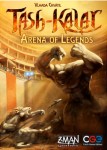 Dylan: This may honestly be the abstract game that breaks the rules of abstracts the most. Each player has a deck of cards that is different from their opponent and is kept hidden. It has a catchup mechanism in the use of the flares, and the ways to score points are flipped up from a deck. But Tash-Kalar offers things that others on this list cannot touch. For starters, pattern building is a huge aspect of the game, which alone isn’t that unique of a mechanic. But coupled with the different faction decks, the patterns are rarely the same between cards and factions (and that is further explored with the three expansions). Those factions also offer ways to explore the game, provide decks suitable to different playstyles, or give a handicap when playing a new player. It’s not for everyone due to luck and a lack of perfect information, but it’s really good.
Dylan: This may honestly be the abstract game that breaks the rules of abstracts the most. Each player has a deck of cards that is different from their opponent and is kept hidden. It has a catchup mechanism in the use of the flares, and the ways to score points are flipped up from a deck. But Tash-Kalar offers things that others on this list cannot touch. For starters, pattern building is a huge aspect of the game, which alone isn’t that unique of a mechanic. But coupled with the different faction decks, the patterns are rarely the same between cards and factions (and that is further explored with the three expansions). Those factions also offer ways to explore the game, provide decks suitable to different playstyles, or give a handicap when playing a new player. It’s not for everyone due to luck and a lack of perfect information, but it’s really good.
2-4 Players • Ages 13+ • 30-60 minutes • Out of Print
2. Hive
 Andrew: Unlike many abstracts, Hive doesn’t have a board to speak of. Each player has a number of different bug tiles, each of which move in different ways. Your goal is to position yourself in a way that you completely surround the queen of your opponent. There is even a pocket-sized edition that is easier to travel with so you can take your abstract gaming anywhere. It has a distinctly chess-like feel without being confined to a grid.
Andrew: Unlike many abstracts, Hive doesn’t have a board to speak of. Each player has a number of different bug tiles, each of which move in different ways. Your goal is to position yourself in a way that you completely surround the queen of your opponent. There is even a pocket-sized edition that is easier to travel with so you can take your abstract gaming anywhere. It has a distinctly chess-like feel without being confined to a grid.
2 Players • Ages 9+ • 20 minutes • $33
2. Go
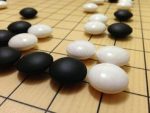 Dylan: In my first games of playing Go, I was resistant to exploring it further. We live in an age where games are played once or twice then sit on a shelf for six months. Go should not be one of those games. Understanding the true strategy and concepts of Go takes repeated plays. I’ve played it 30 times, and I’m still barely scratching the surface of seeing the full scope of the game. When to continue a fight or to step back and start a conflict in another area of the board are questions you must ask yourself. All using a simple mechanic: place a stone.
Dylan: In my first games of playing Go, I was resistant to exploring it further. We live in an age where games are played once or twice then sit on a shelf for six months. Go should not be one of those games. Understanding the true strategy and concepts of Go takes repeated plays. I’ve played it 30 times, and I’m still barely scratching the surface of seeing the full scope of the game. When to continue a fight or to step back and start a conflict in another area of the board are questions you must ask yourself. All using a simple mechanic: place a stone.
2 Players • Ages 8+ • 30-180 minutes • $30
1. Shobu (review)
 Andrew: Shobu is one of the newer games here, debuting last year at Origins. But it’s quickly become the game I just have to show everyone. It looks and feels like a classic abstract that has existed forever. There are four wooden boards (two light and two dark) and river rocks for player pieces. Each turn you make two moves, the first one can’t move any other rocks. The second move must be in the same direction and the same number of spaces and on the opposite colored board. But this second move can push an opponent’s rock, potentially knocking it off the board. If you remove all of your opponent’s rocks from any of the four boards, you win. It’s simple, easy to teach, but has depth that continues to emerge even after dozens of games.
Andrew: Shobu is one of the newer games here, debuting last year at Origins. But it’s quickly become the game I just have to show everyone. It looks and feels like a classic abstract that has existed forever. There are four wooden boards (two light and two dark) and river rocks for player pieces. Each turn you make two moves, the first one can’t move any other rocks. The second move must be in the same direction and the same number of spaces and on the opposite colored board. But this second move can push an opponent’s rock, potentially knocking it off the board. If you remove all of your opponent’s rocks from any of the four boards, you win. It’s simple, easy to teach, but has depth that continues to emerge even after dozens of games.
2 Players • Ages 8+ • 15-30 minutes • $30
 1. Town Center
1. Town Center
Dylan: I’ve spoken about Town Center in our Underrated Games Quest List, but Town Center deserves the praise it rarely gets. The game is only player boards and six colors of blocks, but somehow connects the theme of a city to those abstracted components. The placement of each block results in a city that climbs high above the ground like New York City or remains flat like one of its suburbs. The draft (while introducing a bit of luck) is tense, making sure the active player stacks the blocks in a manner they somehow get the best deal out of it. In terms of abstracts, there aren’t a lot of games like it (it even offers a really fun solo mode), which is why Town Center is my favorite abstract game.
2-4 Players • Ages 12+ • 30 minutes • $68









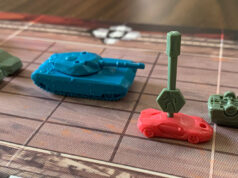











Good to see Hive and Shobū, both best of what abstract can be. Would like to see more love for Onitama and Carnac. Carnac is pricey, which may make it unpopular, but it has mechanics similar to Go.
Why you have the climbers and yinsh two times?
By other side, great article!
Dylan and I worked together and came up with our own top 10s. Those (and Shobu) just happened to be on both of our lists.
I can’t believe you included Alien City,
but not Cones of Dunshire.
It’s all about the cones
Check Zendo
Y’all might really enjoy Hexix. It’s one of the most interesting (and deceptively complicated) abstract area-control games I’ve ever played.
I’m surprised photosynthesis didn’t appear on any of these lists, or patchwork for that matter.
The definition of what constitutes an abstract strategy game has been pretty well settled. Perfect information – no luck involved. Themes have nothing to do with it which is why “Hey, Where’s my Fish?” or “Hive” or Chess are abstract strategy but Backgammon isn’t. Some of these games on this list, such as Tash-Kalar are not abstract strategy either. That’s not to say they aren’t great games, but they’re not abstract strategy.
Pure abstract strategy games like Go, Shobu, Hive, Yinsh, Gipf, Push Fight, Blokus, Tamsk, etc… are a joy to play.
Have you tried Rock Paper Switch from Mindware yet?
It’s Rock Paper Scissors turned into a chess-like board game
Interesting lists. I will try to check out Azul and Santorini. I recommend ConHex and Quoridor. I am a hardcore devotee of both Hex and Twixt, but those games are an acquired taste.